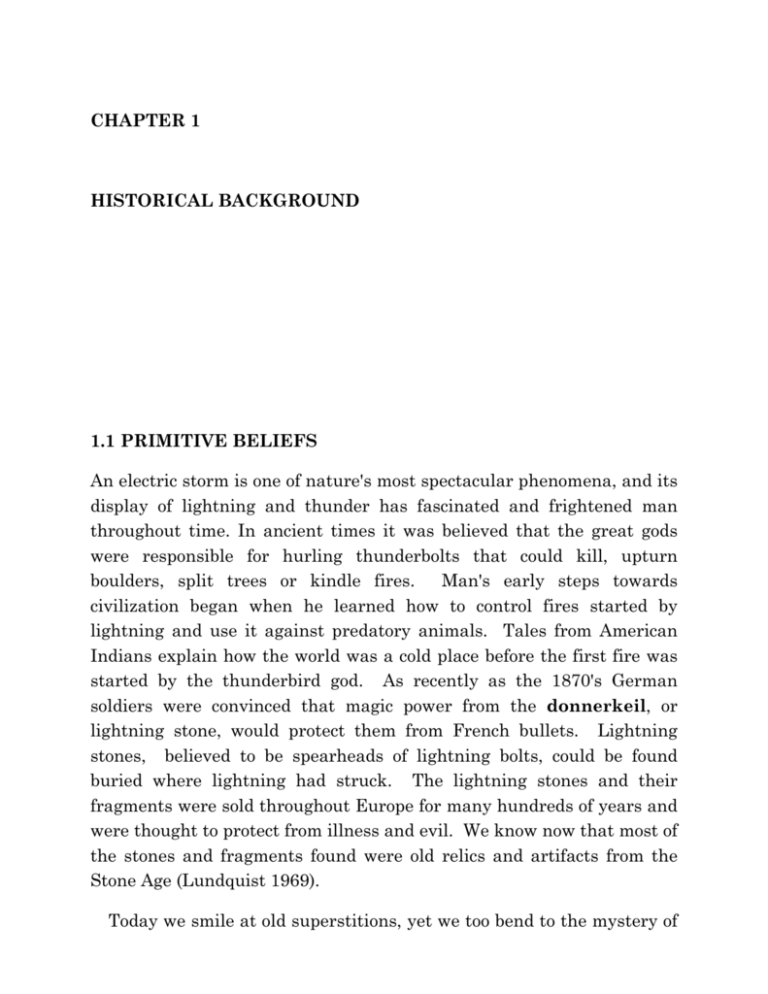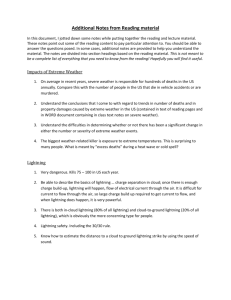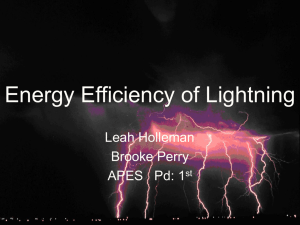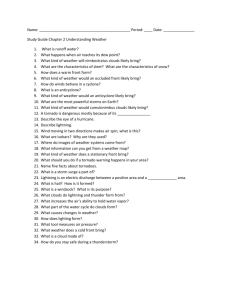Chapter 1 - Colutron
advertisement

CHAPTER 1 HISTORICAL BACKGROUND 1.1 PRIMITIVE BELIEFS An electric storm is one of nature's most spectacular phenomena, and its display of lightning and thunder has fascinated and frightened man throughout time. In ancient times it was believed that the great gods were responsible for hurling thunderbolts that could kill, upturn boulders, split trees or kindle fires. Man's early steps towards civilization began when he learned how to control fires started by lightning and use it against predatory animals. Tales from American Indians explain how the world was a cold place before the first fire was started by the thunderbird god. As recently as the 1870's German soldiers were convinced that magic power from the donnerkeil, or lightning stone, would protect them from French bullets. Lightning stones, believed to be spearheads of lightning bolts, could be found buried where lightning had struck. The lightning stones and their fragments were sold throughout Europe for many hundreds of years and were thought to protect from illness and evil. We know now that most of the stones and fragments found were old relics and artifacts from the Stone Age (Lundquist 1969). Today we smile at old superstitions, yet we too bend to the mystery of 2 ATMOSPHERIC ELECTROSTATICS lightning and its atmospheric implications, for modern man has yet to understand it. 1.2 EARLY ELECTROSTATICS The first person on record to have suggested a relationship between electricity and lightning was an Englishman named D. William Wall (1708). He noted a similarity between lightning and the crackling sparks produced by the rubbing of amber. S. Gray (1735) and A.G Rosenberg (1745) both mention the similarity between lightning phenomena and electric fire produced by electricity machines in the laboratory; and in a book published in Leipzig 1746, J.H Winkler describes several resemblances between lightning and electricity. During this time improved electricity machines and Leyden jars became readily available and a new era of electrical science was born. Many more scientists, among them Benjamin Franklin, also questioned the nature of lightning, recognizing its similarity to the snapping sparks produced in the laboratory. "How loud must be the crack of 10,000 acres of electrified cloud!" exclaimed Franklin. In a letter to Dr. John Mitchel of the Royal Society in England, he enclosed a treatise, "The Sameness of Lightning and Electricity". According to Mitchel, the paper was read by the Society amidst laughter from its professed experts on electricity. Another paper dated July 1750, was sent to the Royal Society through a friend, a Mr. Collinson. In this paper Franklin described how electric "fluid" is attracted to pointed conductors. "Might not the same principles be of use to man in teaching him to protect houses, churches, ships and other structures from damage occasioned by lightning?" he asked. Thus the idea of the lightning rod was born. As yet no experimental tests had been performed to prove that lightning was an electrical phenomenon. Franklin therefore proposed an experiment to answer the question once and for all. On a high tower or steeple a sentry-box was to be erected large enough to contain a man HISTORICAL BACKGROUND 3 and an electrically-insulating platform. A long pointed rod or antenna would be attached to the sentry-box by means of insulators and would be connected to the insulated platform inside (Fig. 1). A man standing on the insulated platform would thus become charged from the rod when a thundercloud passed overhead. At will he might then draw sparks from his fingertips to the surrounding grounded wall. Fig. 1 Franklin’s proposed sentry-box experiment. In principle it was just another lightning rod. From laboratory experiments Franklin knew that charge could be drawn from a nearby charged body by means of a pointed rod, which attracted electric "fire" 4 ATMOSPHERIC ELECTROSTATICS Fig. 2 D'Alibard's version of Franklin's sentry-box experiment. The experiment was never to be performed by Franklin, due to the lack of financial aid, yet with time Franklin's ideas gained increasing approval from the Royal Society. In 1751 several of his papers were published in England in book form and soon thereafter translated into HISTORICAL BACKGROUND 5 French by the naturalist D'Alibard. So intrigued was D'Alibard by the sentry-box experiment that he decided to put it to the test himself. An experimental structure slightly different in design was erected outside Paris at Marly. (Fig. 2). By the 10th of May, 1752 D'Alibard (1752) had successfully determined that thunderclouds are indeed electrically charged. In America a few weeks later Franklin, unaware of D'Alibard's success, performed his famous kite experiment. It was a poor man's experiment, simple and brilliant. It demonstrated that lack of financial help is an insufficient deterrent to genius. (One wonders if Dr. Franklin was advised, when looking for financial support, to go fly a kite). In his kite experiment Franklin not only confirmed the electrical character of lightning but also, more importantly, found clouds to be negatively charged at the base and positively charged on top, thus forming giant electric dipoles floating around in our atmosphere. 1.3 FRANKLIN VERSA NOLLET It is interesting to note that Franklin spoke of positive and negative electricity. This is a product of his own theory on electricity and the concept of positive and negative charge is still being used today. Franklin envisaged electricity as a kind of fluid where a body could have either an excess or a deficit of fluid. For example, if a person standing on an insulated stool were to touch the glass cylinder of an electricity machine he would lose some of the fluid. A deficit or loss of fluid represents a minus state and excess fluid equals a plus state. The sum of positive and negative electricity is always nil. The plus state of the fluid was determined by Franklin as follows: A positively charged pith ball would snuff out the flame on a candle i.e. the flame will retreat from the ball while the ball is trying to rid itself of excess fluid. A modern explanation is that the flame, which contains a great number of positive ions produced by the heat and combustion, will be repelled by 6 ATMOSPHERIC ELECTROSTATICS any other positive charge in its vicinity. One consequence of Franklin's theory is the convention of labelling the direction of electric current. Although in metals the charge is carried by electrons flowing from minus to plus, we are now forced to assume that electric current or charge is flowing from plus to minus in order to keep things algebraically consistent. The Abbè Nollet (1700-1770) of Paris was the authority on electricity in Europe during the time of Franklin's discoveries. Nollet was aware of two different kinds of electricity, namely glass electricity and resin electricity. He believed that the two different kinds of electricity were liquid streams flowing in and out of electrified bodies in opposite directions, effluence and affluence. Nollet maintained a very negative attitude towards Franklin's ideas on electricity and especially to the lightning rod. This is perhaps one reason why it took so long for the lightning rod to become established in Europe. The Abbè Nollet, however, was a master of experimental electricity. He often performed electricity demonstrations before Louis XV and his court. A typical demonstration would be to pass a high voltage static charge from a Leyden jar, through seven hundred monks holding hands, causing them to jump in perfect unison, to the King's delight. Nollet was often criticized for activities such as this. His theories on electricity were eventually abandoned in favour of Franklin's ideas which, to a certain extent, still are used today. 1.4 THE LIGHTNING ROD A year after the famous tests of D'Alibard and Franklin a Russian professor named Richmann attempted to repeat the sentry-box experiment. The result is pictured in Fig. 3. Professor Richmann was killed instantly when lightning struck his antenna on the roof of the laboratory in St. Petersburg. As a result of this accident the general public grew skeptical of the lightning rod as a protective device. HISTORICAL BACKGROUND 7 Fig. 3 Professor Richmann is killed when lightning strikes his experimental antenna in St. Petersburg, 1753. Did not the death of Professor Richmann prove that lightning rods attract lightning? Some twenty years later Europeans finally accepted Franklin's invention, but the arguments against it were many. One such argument, advanced by a number of scientists spearheaded by Nollet, ran as follows: If a large structure like a church steeple is not spared by lightning, 8 ATMOSPHERIC ELECTROSTATICS how much larger must the lightning rod itself be to withstand the devastating power of a severe bolt? The argument seemed valid at the time, for church steeples literally exploded when struck by lightning (Ohm's Law had not yet been formulated). The electric resistance of a church steeple is perhaps one megohm, and since the average lightning bolt carries about 25,000 amperes, it dissipates a peak power of R × I 2 = 6.25 × 10 8 megawatts. Although the duration of the lightning bolt is short, its total energy is considerable. The function of the lightning rod is, of course, to lower the resistance across the structure a million or more times and thus to permit the energy to dissipate into the ground. Fig. 4 Hat pin and umbrella lightning rods (Paris, 1778). Eventually the lightning rod became a common sight on both sides of the Atlantic. Europeans, who had once strongly rejected the notion, embraced it with an enthusiasm that led to extravagant measures for HISTORICAL BACKGROUND 9 protecting life and limb from the perils of lightning (Fig. 4). Ironically, Europeans today are occasionally amused by the different shapes and designs of American lightning rods which they feel are costly and only of psychological importance, see Fig. 5. (Muller-Hillebrand 1963). Fig. 5 Points according to American standards (1959) not cheap and only of psychological importance. 1.5 LATER DEVELOPMENTS The D'Alibard-Franklin experiments were repeated by many investigators and most noteworthy is perhaps L. Lemonnier (1752) who, with his more sensitive apparatus, discovered that weak electrical charges could be detected in the atmosphere in the absence of clouds. He also noticed a difference in electric intensity during night and day. The discovery of Lemonnier is important because it gave birth to a new field of research in atmospheric physics, namely "Fairweather Electricity". 10 ATMOSPHERIC ELECTROSTATICS In 1775 the Italian scientist Beccaria (1775) confirmed Lemonnier's findings with one important addition, that pointed rods and insulated wires suspended in the atmosphere became positively charged relative to the earth's surface during fine weather, under cloud-free skies. This meant that an electric field is present in the atmosphere even when no thunderclouds are near. Beccaria also noticed a polarity reversal when a thundercloud passed overhead, indicating the introduction of negative charge from above. Thus he substantiated Franklin’s earlier finding that thundercloud are generally charged negatively at the bottom and positively at the top, an observation that can be readily confirmed today. The first notable attempt to explain the origin of fairweather electricity was made by Lord Kelvin (1860). He was first to envisage the fairweather field as electric field lines which must stretch from the earth's surface and terminate on charges in the atmosphere. The direction of the field is towards the earth's surface. He theorized that the charged atmosphere forms a giant capacitor with the earth's surface. The capacitor model was later expanded by Kennely and Heavyside (1902) who suggested that the conducting layer in the atmosphere is the ionosphere which forms a spherical capacitor with the earth's surface where each "plate" of the capacitor carries a charge of nearly one million coulombs. A charge of this magnitude will, of course, produce an electric field of a few hundred volts per metre at the earth's surface. This is the normal value of the persisting fairweather field and Lord Kelvin, not knowing what process had charged the capacitor plates, at least seemed to have a reasonable idea explaining the structure of the fairweather field. Unfortunately for the attractive theory, later discovery of ions and cosmic rays proved the atmosphere to be electrically conducting. Lord Kelvin's capacitor model would therefore lose its charge in less than 10 minutes at a rate of nearly 2000 coulombs per second (=2000 amperes). It should be mentioned that C.A. Coulomb, the father of the electrostatic force law, discovered in 1785 that air is slightly conducting, an observation that was not understood at the time. HISTORICAL BACKGROUND 11 Where does the atmospheric fairweather charge come from? How is it replenished at the rate of 2000 coulombs per second? Many answers have been proposed, the most popular being that of C.T.R. Wilson 1n 1925. Wilson suggested that all thunderstorms around the world are electrical generators which by their violent discharges continusally supply electricity to the earth-ionosphere system. More recent evidence, however, weighs heavily against this evocative idea. Insufficient charge is available from worldwide thunderstorms to drive such a global electric circuit. Furthermore, data presented by Imyanitov and Chubarina, among others, demonstrate that annual variations of the fairweather field are not in phase with typical thunderstorm activity throughout the world for the same period. Despite the argument against Wilson’s proposal and the lack of evidence to support it, many investigators still favour the idea since, until very recently, there has been no other explanation available. Now there is a new theory in competition with Wilson’s concept based on the electrochemical properties of the atmosphere. This theory is discussed in Chapters 2 and 3. Serious research on lightning and thunderclouds started late. With the birth of electric power in the early 20th century and the many power failures due to lightning, a better understanding of lightning and thundercloud charging was necessary. Charles Proteus Steinmetz, a German immigrant to America who worked as an engineer at General Electric Laboratories to develop lightning arrestors, might be considered as one of the early pioneers of modern lightning research. His work led to the construction of high-power high-voltage generators which could simulate lightning flashes. The machines consisted primarily of a large capacitor bank which was charged by a high voltage transformer via rectifiers or diodes. For the first time research could be performed on large electric discharges under controlled conditions. Much information was gathered by Steinmetz and his lightning machine which has helped us understand electric transients and has aided in the design of lightning protectors. The invention of the oscilloscope increased our knowledge on the lightning discharge because of its fast response to 12 ATMOSPHERIC ELECTROSTATICS electrical transients. H. Norinder at the University of Uppsala High Voltage Research Institute was first to obtain such oscilliograms from lightning surges in 1925. Parallel with electric research during the first part of the 20th century was the development of high speed cameras which would record the optical properties of lightning. The first camera suitable for recording the rapid changes in lightning flashes was created by Sir Charles Boys who himself, unfortunately, did not obtain any satisfactory pictures of lightning flashes. It was not until 1933 that the Boys camera became a main contributor to what we now know about lightning discharges. It was B.F.J. Schonland and his team in South Africa who discovered the different sequences of a lightning flash with the aid of a Boys camera (Fig. 6) and revealed the initial process of the stepped leader. Boys' pictures show that a bright-tipped leader works its way down from the Fig. 6 Boys’ camera photograph of cloud to ground discharge. cloud in steps. When the leader gets near ground it is met by the main return stroke which carries the main discharge current through the ionized conducting path provided by the leader. Normally the stepped leader is invisible to the naked eye and only the main stroke can be seen. The return stroke therefore, appears to start from ground explaining the saying that lightning travels from ground up. At the present time much is still unknown about atmospheric electricity and its origin. What mechanism is responsible for the build HISTORICAL BACKGROUND 13 up of cloud charges and what generates the electric fairweather field? How is charge drained from a cloud or how does the lightning bolt connect up to all the myriads of charged drops in the cloud? These are still valid questions and, in the author's opinion, is the reason why Atmospheric Electricity is one of the most challenging fields in science today. 14 ATMOSPHERIC ELECTROSTATICS








